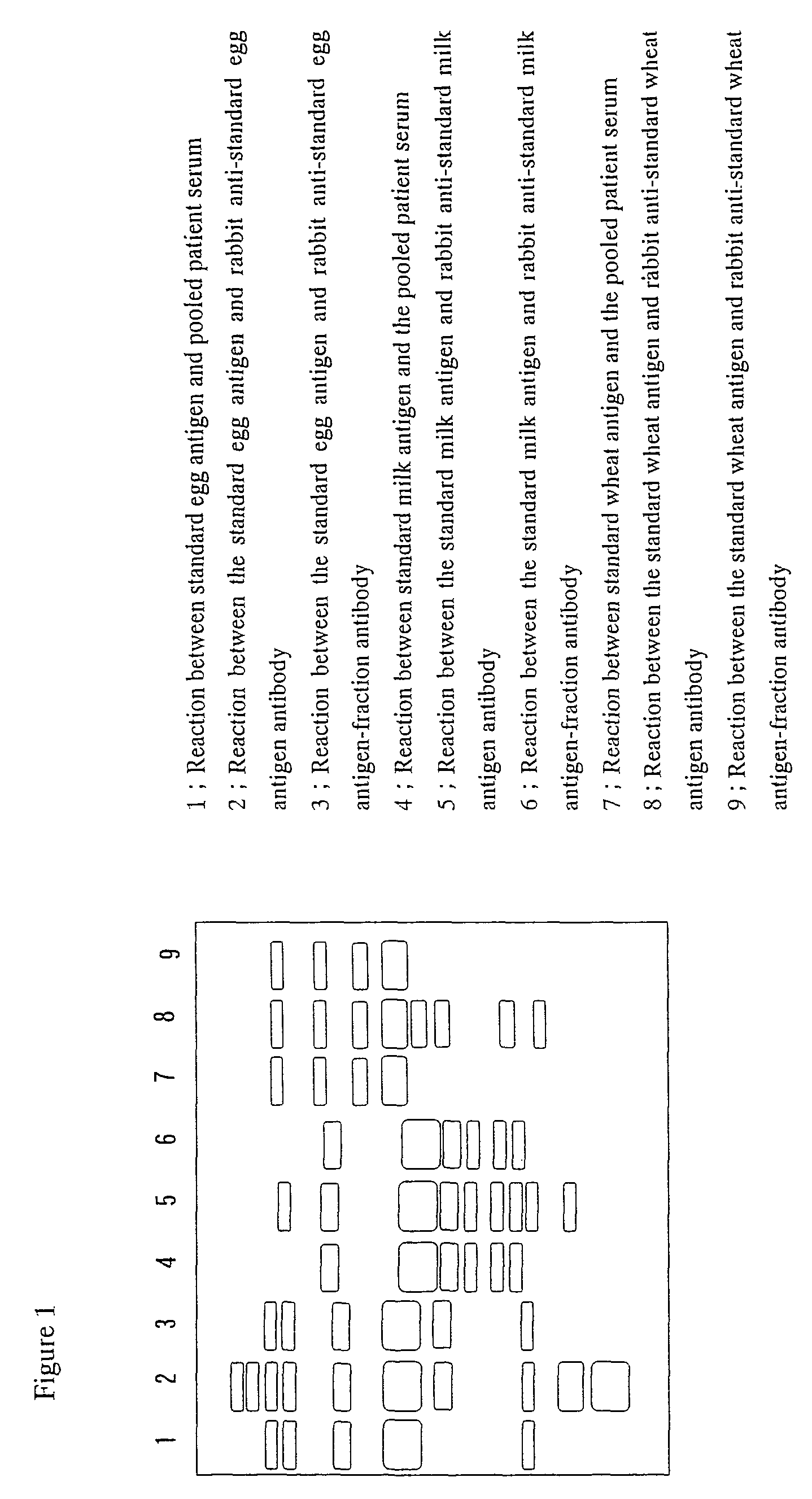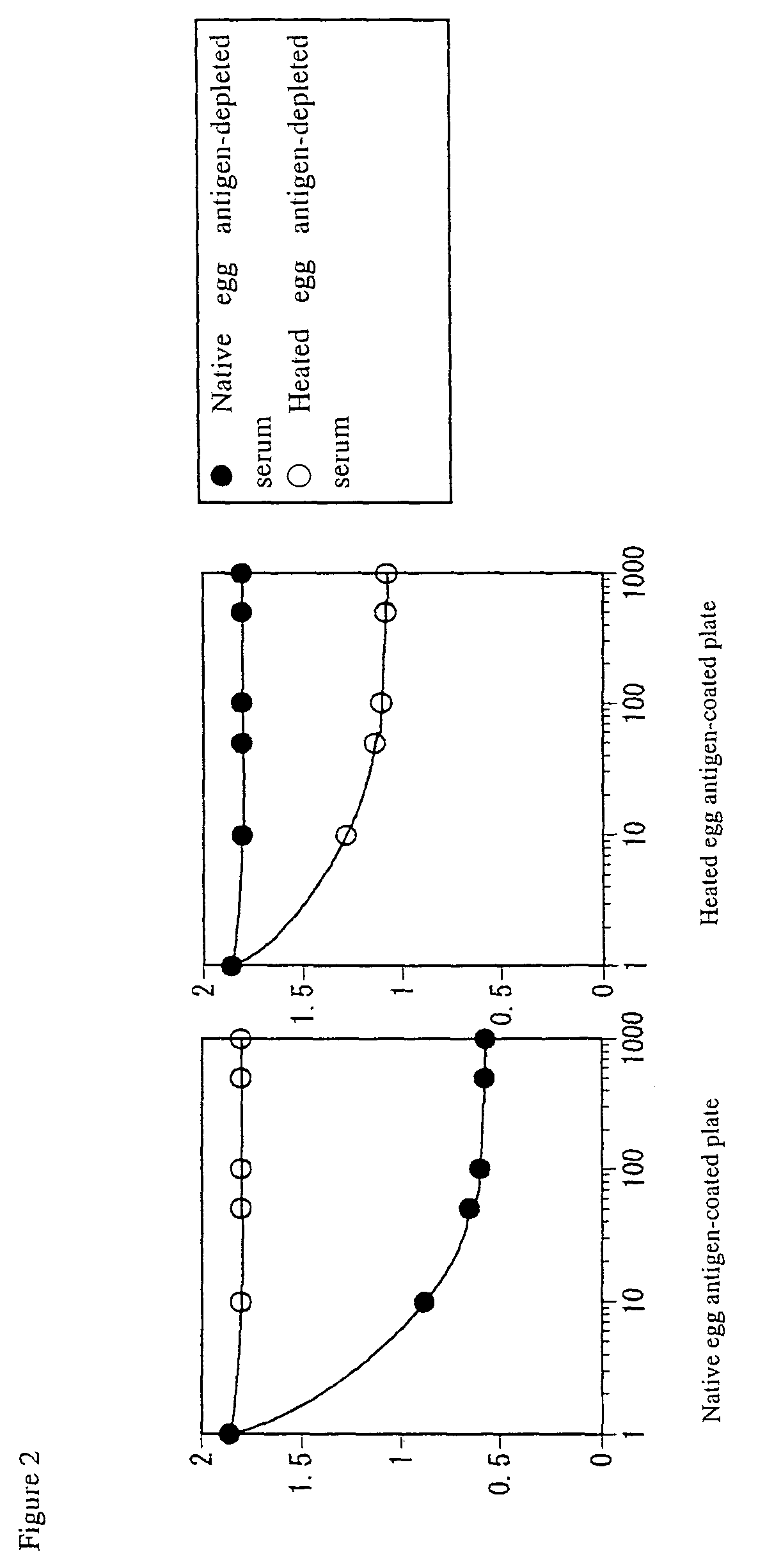Food allergens, method of detecting food allergens and method of detecting food allergy-inducing foods
a technology of food allergens and food allergens, which is applied in the field of food allergens, method of detecting food allergens and method of detecting food allergy-inducing foods, can solve the problems of food allergy, no conventional method, and serious problems in the field of medical science and in the food industry, and can easily detect so many allergy-inducing foods or food allergens,
- Summary
- Abstract
- Description
- Claims
- Application Information
AI Technical Summary
Benefits of technology
Problems solved by technology
Method used
Image
Examples
example 1
Preparation of Standard Antigens of Various Foods
(1) Chicken, Quail and Duck Eggs
[0044]One-kg chicken eggs were shelled, homogenized, freeze-dried and finely ground to prepare a standard chicken-egg antigen. After 10-g antigen was suspended in 10-fold volume of phosphate-buffered saline, pH 7.0 (abbreviated to PBS in the following), and then dispensed into 5 test tubes, which were not heated or heated for 30 min at 60, 80, 100 and 120 degree Celsius, respectively. Then, they were mixed together and homogenized to prepare the sample. Similarly, the samples were prepared with quail and duck eggs.
(2) Cow Milk
[0045]One-litter milk was agitated with cooling to solidify and precipitate milk fat, which was filtered through absorbent cotton. After repeating such a procedure 3 times, the filtrate was freeze-dried and then finely ground to prepare a standard cow-milk antigen. Similarly, the sample was prepared as described in (1).
(3) Wheat and Rice
[0046]One-kg wheat flour was extracted with 5...
example 2
Various Purified Food Allergens
(1) Purified Chicken-Egg Allergen
[0050]Ovoalbumin, a major allergen of chicken egg, was suspended in 10-fold volume of PBS, pH 7.0, and dispensed into 5 test tubes, which were not heated or heated for 30 min at 60, 80, 100 and 120 degree Celsius, respectively. Then, they were mixed together and homogenized to prepare the sample. Similarly, a sample of ovomucoid was prepared. It is known that ovoalbumin and ovomucoid are proteins localized in egg white.
(2) Purified Cow-Milk Allergen
[0051]Similarly as described in Example 2 (1), the samples of casein, beta-lactoglobulin and alpha-lactoalbumin were prepared. It is known that beta-lactoglobulin and alpha-lactoalbumin are proteins localized in milk whey.
example 3
Preparation of Antibody
(1) Preparation of Rabbit Antibodies Against Various Standard Food Antigens
[0052]Each sample prepared in Example 1 was emulsified with Freund's complete adjuvant (used for the first immunization) and incomplete one (used for the second and thereafter immunization) and subjected to immunization of Japanese white rabbits 4 to 6 times. In the meantime, blood was partially collected to confirm production of antibody against the antigen, and then all the blood was collected. Thus, the antibodies were prepared.
(2) Preparation of Antibodies Against Various Purified Food Antigens
[0053]Similarly, antibodies against various purified food allergens were prepared as described above.
PUM
| Property | Measurement | Unit |
|---|---|---|
| Molecular weight | aaaaa | aaaaa |
Abstract
Description
Claims
Application Information
 Login to View More
Login to View More - R&D
- Intellectual Property
- Life Sciences
- Materials
- Tech Scout
- Unparalleled Data Quality
- Higher Quality Content
- 60% Fewer Hallucinations
Browse by: Latest US Patents, China's latest patents, Technical Efficacy Thesaurus, Application Domain, Technology Topic, Popular Technical Reports.
© 2025 PatSnap. All rights reserved.Legal|Privacy policy|Modern Slavery Act Transparency Statement|Sitemap|About US| Contact US: help@patsnap.com


